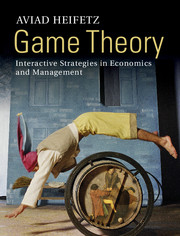Book contents
- Frontmatter
- Contents
- Foreword
- Part I Strategic interactions as games
- Part II Basic solution concepts for strategic form games
- Part III Prominent classes of strategic form games
- 7 Cooperation and conflict, strategic complements and substitutes
- 8 Concentrated markets
- 9 Coordination games and strategic uncertainty
- Part IV Uncertainty and mixed strategies
- Part V Advanced topics in strategic form games
- Part VI Dynamic games
- Part VII Repeated games
- Index
- References
8 - Concentrated markets
from Part III - Prominent classes of strategic form games
Published online by Cambridge University Press: 05 August 2012
- Frontmatter
- Contents
- Foreword
- Part I Strategic interactions as games
- Part II Basic solution concepts for strategic form games
- Part III Prominent classes of strategic form games
- 7 Cooperation and conflict, strategic complements and substitutes
- 8 Concentrated markets
- 9 Coordination games and strategic uncertainty
- Part IV Uncertainty and mixed strategies
- Part V Advanced topics in strategic form games
- Part VI Dynamic games
- Part VII Repeated games
- Index
- References
Summary
One of the most important applications of game theory in economics is that of analyzing the behavior of commercial firms. When production activity in a particular sector is carried out by a small number of firms, the situation is one of oligopoly or concentrated markets.
In some sectors, the prices set by the various firms for their products are either identical or very nearly so. Dairy manufacturers, for example, typically sell a quart of milk at the same or almost the same price. In the dairy market, therefore, firms compete over shelf space in the supermarkets and grocery stores, and, consequently, over the quantities sold to consumers. This is a typical example of quantity competition.
In other sectors, the quantity of units offered to customers is a constant, and firms compete primarily by means of the prices they charge consumers. For example, the flights operated by the various airlines on each route are scheduled well in advance, and the number of seats per airplane of a particular type is constant. Therefore, on short notice, airlines can neither increase nor decrease the number of seats offered to customers. They can, however, compete with each other by making changes in ticket prices and by launching various sales specials. This, therefore, is a typical example of price competition.
The various firms often differentiate products which are by and large similar to one another. For example, dairy manufacturers produce yoghurt treats which are similar but not identical. In this case we say that the firms’ products are differentiated.
If every firm has already reached agreement with the major supermarket chains as regards the shelf space that it is to be allocated for its yoghurt treats, then it remains only for each firm to quote a price for its product. In this case, we say that the firms are engaged in price competition with differentiated products.
But in certain periods, the main decision variable of yoghurt treat manufacturers will not necessarily be that of price. For example, once a new yoghurt treat has been launched, the firm may not wish to make frequent price changes so as not to confuse its customers. The firm may, however, reopen negotiations with the supermarket chains over the quantities of the product they are to purchase and display on their shelves. In this state of affairs, we say the firms engage in quantity competition with differentiated products.
- Type
- Chapter
- Information
- Game TheoryInteractive Strategies in Economics and Management, pp. 118 - 136Publisher: Cambridge University PressPrint publication year: 2012

